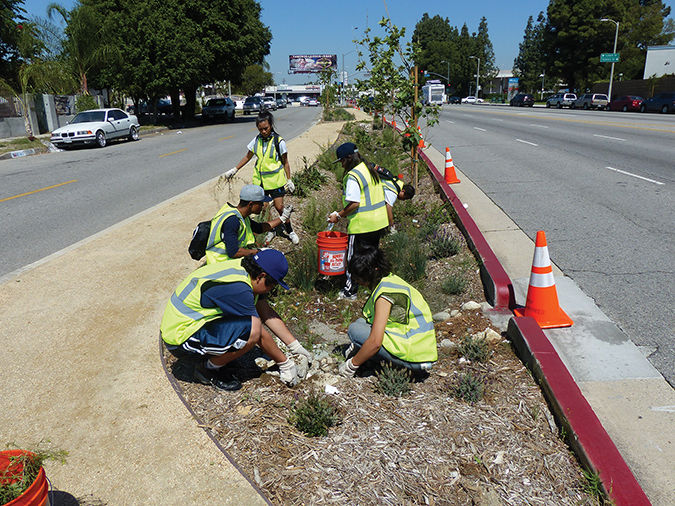Toting orange “Let’s Do This” buckets, six students from St. Genevieve High School began their groundbreaking project: pulling weeds crowding drought-tolerant plants and picking up trash on a newly-retrofitted street median near their Panorama City campus.
School officials had attended the dedication two months earlier of the Woodman Avenue Multi-Beneficial Stormwater Capture Project — replacing a concrete median located on Woodman (between Lanark and Saticoy) with a swale (grassed channel) that can retrieve rain runoff and infiltrate it to groundwater instead of channeling it out to the ocean via the Los Angeles River.
St. Genevieve’s elementary and high schools then accepted an invitation to assist with maintenance of the pioneering project for the next couple of years. Representatives from The River Project — which partnered with the Los Angeles Department of Water & Power and the City’s Bureau of Sanitation & Street Services on a grant from Proposition 50 to retrofit the median — arrived for the school’s “Earth Day” celebration April 15 to educate their first campus group of “median maintenance” volunteers.
“This is a brand new idea for the City of Los Angeles, and it’s being done right here,” said Beau MacDonald, an applied biogeographer who works part-time for The River Project, a non-profit whose motto is “Working toward a living Los Angeles River, Nourished by a healthy watershed.”
Noting the prevalence of impermeable concrete and asphalt in local urban areas, MacDonald pointed out that projects like the completed Woodman Median Retrofit and the ongoing Los Angeles Rainwater Harvesting Project in the Panorama City neighborhood just south of St. Genevieve seek solutions like “curb cuts” and “parkway basins” to retain water for site use and groundwater infiltration.
“Because we have paved over our city, water doesn’t have a chance to sit there and go into the soil,” said MacDonald. “It just gets taken out into the ocean [as well as] an assortment of trash. We’re losing our water by sending it out to the ocean instead of capturing it here, and meanwhile we’re sending all that trash out.”
She explained that the Woodman Median retrofit involved getting rid of a lot of concrete as well as dying magnolia trees and creating a swale with native plants that filter pollutants out of the captured stormwater, which percolates down into the soil. Native oak and sycamore trees were also planted along the median.
“One of the important things you are going to do is make sure these baby trees grow up and live a long life,” said MacDonald, who added that oaks and sycamores are perfectly adapted to the San Fernando Valley’s Mediterranean climate of cool, rainy seasons and hot, dry summers.
She noted that repairs to the median after recent storms have delayed maintenance, allowing some weeds, such as dandelions, to grow quite tall. “These new native plants we’ve planted have trouble competing,” said MacDonald. “They can’t grow and thrive like they’re supposed to if there are a lot of weeds. So, we’re going to deal with weeds and trash.”
Students received gloves for weed-pulling and chartreuse vests for visibility after their walk to the Woodman Avenue Median, which took them by the homes participating in the L.A. Rainwater Harvesting Project. As they worked for a couple of hours before lunch pulling weeds and bagging trash, cars were whizzing by. One driver yelled “Thank You” from his open widow to the students laboring in the bright morning sun.
“This is very experiential,” said senior Rachel Munar-Villasista, who admitted she was having a little difficulty pulling the weeds. “Having my friends here helps me out.”
Fellow senior Andy Liu told The Tidings that maintaining the median is a way to help out the neighborhood and learn about the environment. “I learned how to protect the environment by killing the bad plants hurting the good plants and how cleaning out the trash will protect the water for recycling and storing underground,” said Liu.
“It’s worth it,” he added, “because it doesn’t cost a lot and it just takes some time to clean out the neighborhood. California is a state that does not have a lot of water and is always dry, and I think we should build a really good system to help store the water in the environment.”
Senior Christian Torchon admitted he wasn’t too sure about how the project sounded at first. “But after actually coming out here and performing the task that was asked of us, I feel confident about it,” he said. “The project itself definitely will serve its purpose, and I look forward to helping the school in growing and making this project larger to help serve the community.”
“This is actually a fun activity,” said senior Louie Klemm, student body president. “It seems like we’re actually helping the environment instead of just watching a movie on Earth Day — this is something that will benefit the community.” He added that he learned how to differentiate weeds from other plants and “how sage smells.”
“I think it’s a good [project],” said freshman Keila Vives. “It’s my first time doing something out of school, being part of something, and I kinda like it. When the lady showed us the presentation of the plants, it was really interesting, and I just wanted to go work already.”
“I think I’m really fortunate to have gotten this group of students,” said MacDonald. “They chose to come here. We were picked over an animal shelter, which I know is a great sacrifice, perhaps, but the group of six kids who are here today are all leaders. They’ve done a really fantastic job.”

